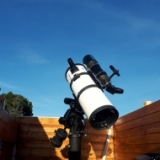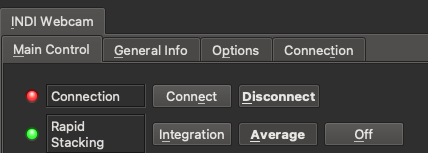RPICam delivers Images very slow
- Andy Buzzard
-
 Topic Author
Topic Author
- Offline
- New Member
-

RPICam delivers Images very slow was created by Andy Buzzard
i am new here and could not find any post regarding a problem same as mine. so please forgive me if i was blind
I tried first with an raspberry 3B and after that with a new 4B (4GB Version) , same effect. Both have the actual Firmware running.
The Raspberry has the newest stable Raspi-OS and i installed INDI via the astroberry.io repository as described in the FAQ.
Everything works very well, except the Raspicam Module (or maybe the camera itself?) I can connect with PHD2 Guiding (running on my pc) over LAN and i get the Picture, but the Update needs more than 3 seconds to the next Image.
The polling frequency is set to 0.5s, the PI has 256MB shared video Memory, and a load Average while guiding around 0.2. So i don't see any bottleneck
Do you have any clues for me where i may start debugging? Or is this a normal behaviour with this camera?
Thanks in advance and best regards
Andy
Please Log in or Create an account to join the conversation.
- Andy Buzzard
-
 Topic Author
Topic Author
- Offline
- New Member
-

Replied by Andy Buzzard on topic RPICam delivers Images very slow
very strange and i don't get the problem
Please Log in or Create an account to join the conversation.
- Rob Lancaster
-

- Offline
- Supernova Explorer
-

- Posts: 2885
- Thank you received: 819
Replied by Rob Lancaster on topic RPICam delivers Images very slow
Please Log in or Create an account to join the conversation.
INDI Library v2.0.7 is Released (01 Apr 2024)
Bi-monthly release with minor bug fixes and improvements
- Andy Buzzard
-
 Topic Author
Topic Author
- Offline
- New Member
-

Replied by Andy Buzzard on topic RPICam delivers Images very slow
Rendering Error in layout Message/Item: array_keys(): Argument #1 ($array) must be of type array, null given. Please enable debug mode for more information.
Please Log in or Create an account to join the conversation.
- Andy Buzzard
-
 Topic Author
Topic Author
- Offline
- New Member
-

Replied by Andy Buzzard on topic RPICam delivers Images very slow
Rendering Error in layout Message/Item: array_keys(): Argument #1 ($array) must be of type array, null given. Please enable debug mode for more information.
Please Log in or Create an account to join the conversation.
- Rob Lancaster
-

- Offline
- Supernova Explorer
-

- Posts: 2885
- Thank you received: 819
Replied by Rob Lancaster on topic RPICam delivers Images very slow
Please Log in or Create an account to join the conversation.
- Andy Buzzard
-
 Topic Author
Topic Author
- Offline
- New Member
-

Replied by Andy Buzzard on topic RPICam delivers Images very slow
and the best is - the RPI Cam works with indi_webcam_ccd great. The resolution is at 1600x1200 okay with less than 1s delay. if i set the resolution to 640x480 the delay is nearly gone.
if i try to set the correct resolution PHD2 crashes totally
for guiding it would work for me with this lower resolution. i wonder if the binning is working with the indi_rpicam driver? i set 4x4 binning, but nothing happened - it should be much brighter, but no effect. i would love to have the binning feature , but if it isn't working with this camera, i can use the webcam driver too and i don't have a need for the rpicam driver.
edit: and it looks like the exposure settings does not work - i can't modify the expsure time. well - i can, but it is ignored
Please Log in or Create an account to join the conversation.
- Rob Lancaster
-

- Offline
- Supernova Explorer
-

- Posts: 2885
- Thank you received: 819
Replied by Rob Lancaster on topic RPICam delivers Images very slow
Please Log in or Create an account to join the conversation.
- Andy Buzzard
-
 Topic Author
Topic Author
- Offline
- New Member
-

Replied by Andy Buzzard on topic RPICam delivers Images very slow
later this day, i will play a bit with the options in the webcam driver - maybe i can make the cam with it a bit more useful and fix the exposure time bug.
(i noticed that even the indi_rpicam does not react to different expsure settings in PHD2 - maybe there is the BUG)
i will update as soon i figured it out where the problem lies.
Please Log in or Create an account to join the conversation.
- Rob Lancaster
-

- Offline
- Supernova Explorer
-

- Posts: 2885
- Thank you received: 819
Replied by Rob Lancaster on topic RPICam delivers Images very slow
Please Log in or Create an account to join the conversation.
- Rob Lancaster
-

- Offline
- Supernova Explorer
-

- Posts: 2885
- Thank you received: 819
Replied by Rob Lancaster on topic RPICam delivers Images very slow
Please Log in or Create an account to join the conversation.
- Andy Buzzard
-
 Topic Author
Topic Author
- Offline
- New Member
-

Replied by Andy Buzzard on topic RPICam delivers Images very slow
i think i will give it a shot and try it in the next clear night. (sadly very rare at this time in germany)
i will keep this post updated and it would be a pleasure for me, if someone has maybe a clue for the indi_rpicam driver. maybe all will work in a new build
thank you so far!
Please Log in or Create an account to join the conversation.

